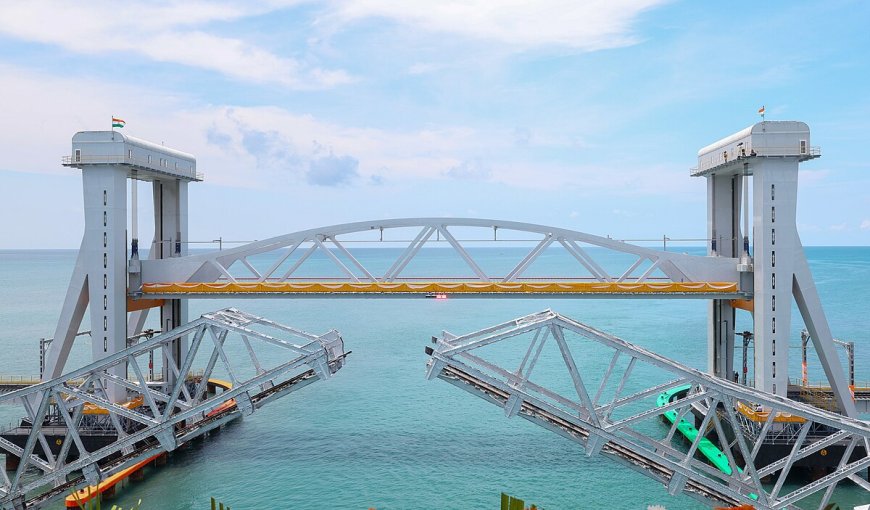Discover the Marvel of Engineering: New Pamban Bridge
Explore the incredible story behind the new Pamban Bridge. Discover where is Pamban Bridge, its length, history, and its importance to Rameshwaram and Indian rail heritage.

India is known for its engineering marvels, and one such iconic structure that continues to fascinate travelers, engineers, and history enthusiasts alike is the Pamban Bridge. Nestled in the southernmost part of Tamil Nadu, this bridge connects the mainland of India to the island of Rameshwaram. For over a century, it has stood as a testament to Indian ingenuity and determination, braving harsh seas, strong winds, and natural calamities. And now, a new chapter begins with the new Pamban Bridge, which is a modern upgrade to its predecessor. With enhanced technology and design, this new structure is built to serve generations to come while honoring the legacy of the original.
The Historical Importance of the Pamban Bridge
Before understanding the significance of the new construction, its important to look back at the journey of the original Pamban Bridge. Commissioned in 1914, it was Indias first sea bridge and served as a critical link for transporting goods and pilgrims to Rameshwaram. The Pamban Bridge Rameshwaram route is not just a lifeline for locals but also a spiritual pathway for millions who visit the sacred Rameshwaram temple each year.
This bridge has withstood several cyclones and extreme weather conditions, most notably the 1964 cyclone that devastated much of the area. Despite damages, it was always restoredproving its resilience and value to the region. Over the years, however, with the increase in rail traffic and the need for better safety and efficiency, the idea for a modern, more robust bridge was conceived.
The Vision Behind the New Pamban Bridge
The new Pamban Bridge is designed with modern-day engineering advancements to replace the old structure and enhance the safety, speed, and convenience of railway operations. Unlike the manually operated mechanisms of the old bridge, the new one boasts an automated vertical lift mechanism to allow ships to pass seamlessly underneath.
This upgrade is not just about technology; it's about preserving the historical spirit while moving toward the future. The government has aimed to retain the significance of the original while ensuring the region remains well-connected and prepared for growing transportation demands. The foundation was laid in 2019, and the construction has drawn attention both nationally and globally due to its complexity and the sensitive environment in which it is built.
Where is Pamban Bridge Located?
Many people often ask, where is Pamban Bridge? It lies in the southern part of India, in the state of Tamil Nadu. The bridge connects the town of Mandapam on the mainland to the island of Rameshwaram over the Palk Strait. Its strategic position makes it the only link by rail to the island, apart from a parallel road bridge built later. The region is scenic and culturally rich, attracting tourists, photographers, and devotees alike.
Travelers who take the train journey across the bridge often describe it as an unforgettable experience, where the train appears to float over the sea, surrounded by calm blue waters on either side. With the upcoming completion of the new bridge, this experience is expected to become even more seamless and awe-inspiring.
Engineering Marvel: Pamban Bridge Length and Design
The Pamban Bridge length has always been a topic of curiosity and admiration. The old bridge spanned approximately 2.065 kilometers and had 143 piers, with a double-leaf bascule section that could be manually opened to allow ships through. With the new design, engineers have focused on building a more durable and efficient structure.
So, what is the Pamban Bridge length in km for the new construction? It remains close to the original, stretching over 2 kilometers across the sea, but with enhanced materials and design methodologies that allow for faster train movement, reduced maintenance, and better weather resistance. The vertical lift span is capable of rising up to 63 meters to let ships passa significant upgrade from the earlier manual system.
This bridge is not just about statistics; its a story of adapting age-old concepts with futuristic design. The alignment has been carefully planned to minimize disruption to marine ecosystems and traditional fishing routes, making it a model of environmentally-conscious engineering.
Rameshwaram Pamban Bridge: A Spiritual and Tourist Icon
Beyond its mechanical brilliance, the Rameshwaram Pamban Bridge is emotionally and spiritually significant to millions. Rameshwaram is one of the holiest places in Hinduism, believed to be where Lord Rama built a bridge to Lanka in the epic Ramayana. Pilgrims often start their visit by crossing the sea on this very railway route, making the bridge more than just a mode of transport.
The new bridge only adds to this spiritual journey, offering a safer, faster, and more comfortable passage for devotees and tourists. The construction itself has drawn more attention to the region, boosting tourism and local businesses.
The scenic views from the bridgewhere ocean waves brush against the piers and fishing boats dot the horizonoffer a unique travel experience. Photographers and filmmakers have long used this location for its dramatic and peaceful visuals, and the new bridge is expected to continue this legacy with its modern aesthetic.
The Future of Connectivity and Development
The completion of the new Pamban Bridge marks a significant step toward improving connectivity in Indias coastal regions. Once operational, it will support trains at higher speeds, reducing travel time and increasing cargo movement capacity. This is not just a benefit for tourists, but also a critical development for industries and the local economy.
With this new infrastructure, the region will also see enhanced safety protocols, thanks to stronger materials, automated systems, and intelligent monitoring. The bridge is designed to handle harsh marine conditions better and has been constructed with sustainability and resilience in mind.
Beyond the economic and technological impact, this bridge is a symbol of Indias ability to blend tradition with modernity. It serves as a proud continuation of a legacy that began over a century ago.
Conclusion: A Bridge Between Eras
The story of the Pamban Bridge is not just one of engineering; its a tale of culture, spirituality, endurance, and evolution. From its origins in the early 20th century to the upcoming debut of the new Pamban Bridge, it has served as a bridge between erasconnecting people, traditions, and regions.
As visitors stand on the shores of Tamil Nadu and look out toward Rameshwaram, they are not just seeing concrete and steel; they are witnessing history in motion. Whether its your first trip or a return journey, crossing this iconic bridge is bound to leave an impression on your heart, just as it has on the history of Indian railways.






































